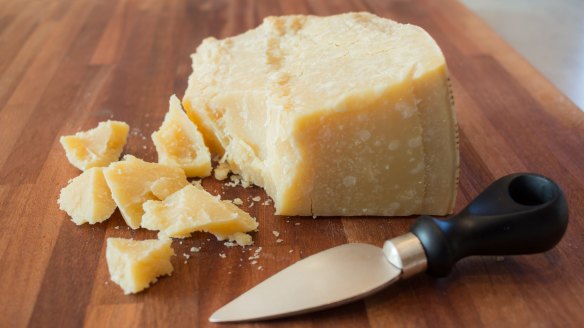What are those weird, crunchy bits in cheese?

What are those weird, crunchy bits in cheese? L. Lee
I had a pleasurable chat about crunchy "cheese crystals" with Australian cheese legend Richard Thomas.
"I remember when Epicure cheese used to arrive from New Zealand in a tin," Thomas said.
"It was 36 months old and when opened, not all the tins were great. Others, however, were diamonds. They had great complexity and dotted with lovely, crunchy 'cheese crystals'."
As cheeses like cheddar mature, calcium and lactic acid combine to form calcium lactate crystals. Calcium lactate is generally found in aged cheddar, parmesan and gouda cheese. The crystals can form both inside and on the outside of the cheese, and can be a sign that moisture has collected inside packaging. Smaller white tyrosine crystals commonly form in aged romano, parmesan and gruyere cheeses.
Tyrosine is a non essential amino acid that is metabolised in the body to help produce chemicals such as dopamine. This is a neurotransmitter that helps control the brain's reward and pleasure centres. Both are naturally occurring and tyrosine can help improve the perception of savouriness in a cheese.
"I like the crunch of cheese crystals," says Thomas. "It is part of the pleasure of aged cheese."
Cheese crystals also form in some blue cheeses. So there is nothing to worry about. Keep calm and pass the quince paste.
What is the perfect way of storing cheese? J. McAllister
Eat it. In the perfect world you would buy perfectly matured cheese from your cheesemonger and eat it within a few days. Unfortunately, life gets in the way of good cheese and sometimes we need to store them.
Soft and washed rind cheeses are living things; the moulds and bacteria still working away to break down the proteins. The perfect temperature to store a cheese is cellar temperature, around 14C. This is the temperature that great cheeses such as Gruyere de Comte are aged at for 18 months to three years in caves and underground tunnels.
One French affineur, or someone who matures cheeses to perfection, uses the tunnels in a fort built by Napoleon in Jura. Here the humidity is perfect and the airflow is slow, so the cheeses don't dry out.
With all this in mind, we need to firstly protect cheese from air flow. Never use plastic film. It makes cheese sweat and turns blue cheese to brown mush. Use baking paper or greaseproof paper. Expensive beeswax cloths are perfect. The cheese needs to breath – the baking paper allows that. Stephanie Alexander suggests a large Tupperware or similar container lined with a bamboo sushi mat. Stephanie took a red-hot skewer and punched holes in the top to allow gentle air flow. Your fridge is at or below 4C so is never going to be perfect to store table cheeses that one serves at a meal. Bring these out several hours before serving to allow them to come to room temperature. This is not necessary for grating or grilling cheeses.
*Send your vexing culinary conundrums to brainfood@richardcornish.com.au or tweet to @Foodcornish
Appears in these collections
From our partners
Original URL: https://www.theage.com.au/goodfood/what-are-those-weird-crunchy-bits-in-cheese-20170511-gw2fn4.html
